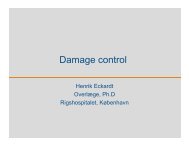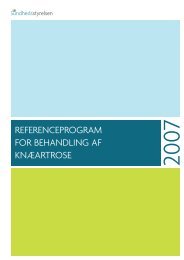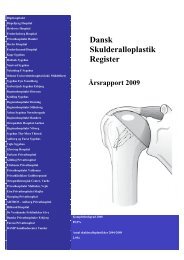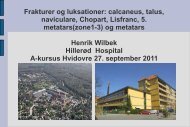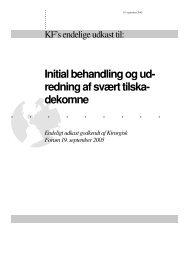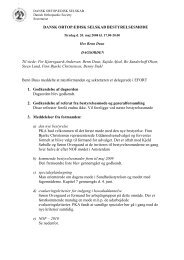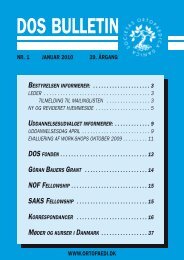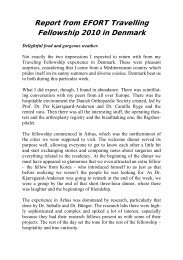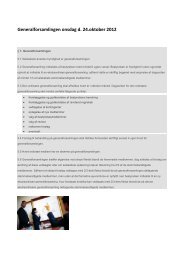DOS BULLETIN - Dansk Ortopædisk Selskab
DOS BULLETIN - Dansk Ortopædisk Selskab
DOS BULLETIN - Dansk Ortopædisk Selskab
You also want an ePaper? Increase the reach of your titles
YUMPU automatically turns print PDFs into web optimized ePapers that Google loves.
2010-378_<strong>DOS</strong> nr. 3 2010 29/09/10 10:08 Side 121<br />
Periacetabular osteotomy in the treatment of anterior<br />
femuroacetabular impingement (FAI) caused by<br />
acetabular retroversion<br />
Ole Ovesen, Søren Overgaard<br />
Dept of Orthopaedic Surgery and Traumatology.<br />
Odense University Hospital<br />
Background: The retroverted acetabulum can lead to FAI and has been<br />
acknowledged as a pre-osteoarthritic (OA) abnormality. This abnormality can<br />
be corrected by a periacetabular osteotomy (PAO) and reorientation of acetabulum<br />
Purpose: Was to evaluate disease specific outcome (HHS), health related quality<br />
of life (EQ5D), achieved radiographic corrections, postoperative activity,<br />
satisfaction and any complications related to surgery<br />
Methods: Since may 2004 27 PAOs were done due to acetabular retroversion.<br />
Inclusion criteria were symptomatic hip pain and radiographic proven retroversion<br />
of the acetabulum. The correction consisted of a combined flexion/internal<br />
rotation and, if necessary, an adduction. In order to achieve a sufficient correction,<br />
a new modification of the procedure has been introduced, consisting of<br />
removal of a wedge of iliac bone. Eigth patients were excluded from this analysis<br />
due to combined surgery or a follow up shorter than 6 months. HHS,<br />
EQ5D, pain on a VAS-scale after 30 min of walk and intraoperative variables<br />
were registered prospectively. The acetabular retroversion in terms of “figure of<br />
8” and “posterior wall sign” was evaluated and quantitated on pre- and postoperative<br />
pelvic radiographs in addition to the lateral center edge (LCE) – and<br />
acetabular index (AA)angle. In one case preoperative radiographs were no<br />
longer available. Finally a questionnaire was sent to evaluate the patients subjective<br />
estimation regarding level of activity , “willingness to repeat the procedure”<br />
and EQ5D.<br />
Findings: No major complications were encountered. Average (95% cfi) HHS<br />
improved from 72 (69-75)-96 (93-100), EQ5D from 0.71(0.65-0.76) –<br />
0.92(0.86- 0.97) and pain from 6.3(5.4-7.2) – 0.6 (0.1-1.0) (p



